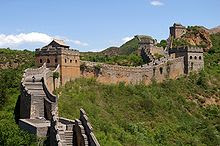THE GREAT WALL OF CHINA




 The Great Wall of China is actually a series of walls built over the course of approximately 2000 years. The wall was built by a succession of Chinese Emperors and rulers as a military fortification to protect against encroaching enemies. It began by connecting smaller fortifications built by earlier leaders. How long is the Great Wall of China? That number is up for debate. Some historians put the length of the Great Wall at anywhere between 1,500 and 2,600 miles, spanning from western Jiayuguan, past the Gobi Desert, over the Yellow River, past Beijing and through to Shanhaiguan on the Bohai Sea. If you ask other historians how long is the Great Wall of China, they may tell you that the length of the Wall is actually closer to 4,000 miles. From its lowest point in the desert, parts of the wall reached heights of over 6,000 feet. Today, fragments of the Wall in various states of disrepair line the countryside of northern China.
The Great Wall of China is actually a series of walls built over the course of approximately 2000 years. The wall was built by a succession of Chinese Emperors and rulers as a military fortification to protect against encroaching enemies. It began by connecting smaller fortifications built by earlier leaders. How long is the Great Wall of China? That number is up for debate. Some historians put the length of the Great Wall at anywhere between 1,500 and 2,600 miles, spanning from western Jiayuguan, past the Gobi Desert, over the Yellow River, past Beijing and through to Shanhaiguan on the Bohai Sea. If you ask other historians how long is the Great Wall of China, they may tell you that the length of the Wall is actually closer to 4,000 miles. From its lowest point in the desert, parts of the wall reached heights of over 6,000 feet. Today, fragments of the Wall in various states of disrepair line the countryside of northern China.The History of the Great Wall of China
The history of the Great Wall of China is as bloody and gruesome as the history of ancient Chinese civilization itself. Construction of the Wall began in the third century B.C. when the first Emperor of China, Qin Shih Huang Di engaged in a bloody battle and ultimately succeeded in uniting what was known as “the Warring States.” For the first time, China was unified. But with enemies all around, particularly the Mongols encroaching from the North, Emperor Qin set about to strengthen his defenses. He gathered a work force consisting of 200,000 convicts and 100,000 soldiers and commissioned them to build a barrier that would thwart all enemies. It took 10 years to construct this wall, often referred to as the first Great Wall of China. During this time, thousands of workers would die from exposure to the elements and fatigue. Others died from enemy military action that cropped up during the building of the wall. And still other workers were put to death at the end of the construction project so as not to reveal secrets of the construction itself. In fact according to the history of the Great Wall of China, so many workers were said to have died during its building, that it is often referred to as “the longest cemetery on Earth” or the “longest graveyard.”
One famous myth about the building of the Great Wall involved Chinese wife Meng Chiang-nu, whose husband had been called to work on the Wall. After he had been gone a long time, she went searching for him. Unable to find him and overcome with grief, the legend goes that her tears were so bitter and copious that the Great Wall opened up and surrendered the body of her beloved husband.
Work on the Great Wall Continues
Although the Great Wall of China was conceived and started during the reign of Emperor Qin, the Wall that exists today for tourists to see was primarily built during later periods. During the first century B.C.E., the third century C.E., the Han and Sui Dynasties respectively sent men to expand the breadth of the Great Wall. And in the twelfth century, during a period in Chinese History called 10 Kingdoms, the Great Wall construction on the Great Wall continued. The construction during all these periods, including the first building of the Great Wall during the Qin period was done in a similar manner using packed earth to form the wall and interspersing tall watch towers along the Wall so the kingdoms could see marauders invading from a distance. The portion of the Wall that is most visited today was built by the Ming Dynasty in the middle ages, during the years 1368 through 1644. The Ming Dynasty built its portion using stronger materials such as brick and stone. This is why today, in Chinese cities like Beijing, tourists are able to see parts of the Great Wall that are largely intact. Although invaders such as the Mongols and the Manchus were able to take control of China during the Ming Dynasty, it is said that no foreign enemy ever breached the Wall. Every successful invasion was due to a breakdown in the government and political weakness and not the weakness of the Great Wall itself. The Wall was made a UNESCO World Heritage Site in 1987 and is currently the subject of a restoration effort by the Chinese government.

No comments:
Post a Comment